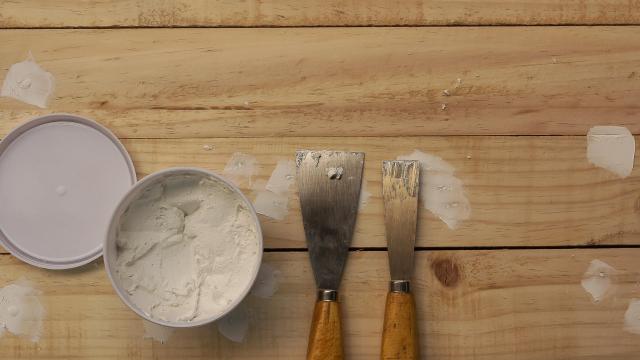One of the benefits of using wood to build furniture, structures, and other objects is its ability to be fastened together using materials like screws, nails, and glue, and techniques like dovetailing. And because wood is a natural material, when you’re working with lumber (as opposed to particle board), whatever you make will be unique, thanks to its grain and knots.
Wood, under some circumstances, can also be forgiving — like if you need to fill in a crack, nail hole, or a larger missing chunk. And that’s where wood putty and wood filler come in. Here’s the difference between wood putty and wood filler, and when to use each.
The difference between wood putty and wood filler
Wood putty and wood filler may sound like they’re the same thing, but the materials shouldn’t be used interchangeably. Here’s what to know about each:
Wood putty
- Oil-based compound with other natural or plastic ingredients
- Denser than wood filler
- Have to apply it with a putty knife
- Stays pliable, even when in use
- Can’t sand it
- Difficult to stain
- Comes in a variety of colours to match stained or varnished wood
- Can be used indoors or outdoors
Wood filler
- Typically a mixture of wood fibres (like sawdust) and a hardening resin (either water or petroleum-based) that soaks into and bonds with the wood fibres
- Hardens as it cures
- Can be sanded
- Can be stained and to match the wood
- Typically used for indoor wood
When to use wood putty vs. wood filler
Because of their properties and composition outlined above, wood putty and wood filler each best for specific (and different) tasks. Here’s when to use wood putty versus wood filler:
When to use wood putty
- On woodwork that expands and contracts based on the humidity (like in a bathroom or basement)
- On wood that has already been varnished or stained
- To fill in dents, cracks, scratches, and small holes in finished furniture, flooring and interior woodwork
- To fill in gouges and cracks in exterior woodwork
- To fix cracks in decking boards
When to use wood filler
- To patch interior woodwork before staining and finishing
- To fill in nicks, scratches, holes, and gouges in unfinished furniture and wood flooring
- To shape damaged edges on tabletops, countertops and shelving
In most cases, the decision of which material to use is pretty straightforward, based on where the wood is located and whether or not it’s finished.

Leave a Reply
You must be logged in to post a comment.